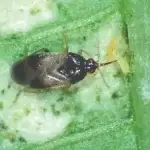Plague Thrips
Overview
The Plague Thrip (Thrips imaginis) is common to most of the crop production regions in mainland Australia and Tasmania. It is a pest of a range of crops including lettuce, beans, tomatoes, strawberries, cucurbits and stone and pome fruit.
Plague Thrips are relatively small thrips, with females ranging in size from 1.1mm to 1.3mm. On stone and pome fruit, Plague Thrips are the most commonly found thrips during the flowering period.
Why you need to control Plague Thrips
Plague Thrips tend to feed in protected places on fruit and often between fruits or under leaves late in the season.
You will see feeding damage as small silver patches on leaves where the Plague Thrips have removed the cell contents. On coloured petals, white/silver patches can appear where they have removed the pigment, and later the petals turn prematurely brown.
Feeding damage to young developing buds can result in stunted or deformed flowers, while feeding damage towards the end of flowering will result in stunted or deformed fruit.
Plague Thrips are not vectors of the Tomato Spotted Wilt Virus.
Beneficial predators to control Plague Thrips among crops
Biological Services sells a range of products to help you control Plague Thrips in your commercial crop and can design a program incorporating Orius, Cucumeris, Hypoaspis miles (Hypoaspis), Franklinothrips vespiformis (Frankie) and Typhlodromips montdorensis (Monty). In Spring and early Summer high numbers adults can migrate quickly from drying pastures. In these scenarios some chemical intervention may be required to lower numbers at critical crop stages.
You can also use yellow and blue sticky traps and rolls to help you monitor and mass-trap Plague Thrips.
Get tailored advice for your commercial crop
To speak with one of our qualified consultants about your current commercial crop challenge or to learn about the benefits of the IPM maintenance and monitoring services we provide, contact us.













